-
Paper Information
- Next Paper
- Previous Paper
- Paper Submission
-
Journal Information
- About This Journal
- Editorial Board
- Current Issue
- Archive
- Author Guidelines
- Contact Us
Advances in Computing
p-ISSN: 2163-2944 e-ISSN: 2163-2979
2013; 3(3): 60-72
doi:10.5923/j.ac.20130303.05
Applying Gagne’s Nine Events in the Design of an Interactive eBook to Learn 3D Animation
Hamed Al-Qassabi, Hosam Al-Samarraie
Centre for Instructional Technology and Multimedia, Universiti Sains Malaysia, Penang, Malaysia
Correspondence to: Hamed Al-Qassabi, Centre for Instructional Technology and Multimedia, Universiti Sains Malaysia, Penang, Malaysia.
| Email: |  |
Copyright © 2012 Scientific & Academic Publishing. All Rights Reserved.
This paper described the effects of using multimedia tools in teaching and learning where students can be engaged in an interactive learning experience. Based on the literature, we found that interactivity can be carried through the implications of instructional design theories. Therefore, we designed an eBook to provide different interactivity elements in order to motivate students to learn 3D animation course. The Gagne’s nine events were incorporated into the design of eBook. Further study should focus on the evaluation of the proposed design.
Keywords: Interactivity, Online resources, Instructional design
Cite this paper: Hamed Al-Qassabi, Hosam Al-Samarraie, Applying Gagne’s Nine Events in the Design of an Interactive eBook to Learn 3D Animation, Advances in Computing, Vol. 3 No. 3, 2013, pp. 60-72. doi: 10.5923/j.ac.20130303.05.
Article Outline
1. Introduction
- The use of multimedia technologies in education has enabled teachers to simulate final outcomes and assist students in applying knowledge learned from textbooks, thereby compensating for the deficiency of traditional teaching methods. Zhang (2012)[1] reported that it is important to examine how effective these technologies are in practical use. The study developed online learning-teaching resource platforms using Flash multimedia, providing interactive and integrated features in an easy to- use user interface, in order to discuss Computer-Aided Drawing .In same area according to Gertner (2011)[2], multimedia technology is somewhat similar to a traditional textbook in terms of holding information. However, the ability to manipulate the text itself through an electronic device holds the potential for students to work with the media thereby allowing a more exciting method compared to standard note taking. Multimedia technology has the potential and functionality to hold enjoyment for users compared to that of a standard textbook. Al-Oraini (2012)[3] mention that the concept of multimedia technology is broad & it has infinite usage fields.It is a profound element as an educational technology in addition to its use in medical &statistical domains &in establishing databases.Moreover, the researcher affirmed that multimedia are one of the best educational techniques because it addresses more than one sense simultaneously, as it addresses the senses of sight & hearing. Multimedia programs provide different stimuli in their presentations which include a number of elements some of which are texts, spoken words, sound & music, graphics, animations and still pictures. It gives a teacher options in how he or she can reach all the learners in the class. Computers in the classroom provide students with the opportunity to get practice on basic content skills as well as enrichment opportunities.In addition, Ahmad, et al (2010)[4] add that with the emergence of the development of the information and communication technology, multimedia has been greatly adopted in the field of education. Audio, video and animation are integrated with instruction in order to create a more interesting, supportive and learning-conducive environment. Ng, et al. (2009)[5] believe that interactive multimedia and human-computer interaction technologies are effecting and contributing towards a wide range of developments in all subject areas including contemporary performing arts. These include augmented instruments for interactive music performance, installation arts and technology-enhanced learning. Consequently, the preservation of interactive multimedia.On the other hand, Chen, Chih-Ming, & Ying-Chun Sun (2012)[6] pointed out that educational materials are no longer limited to static text; that is, the presentation is being transformed from text-based materials to multimedia materials to harness learner attention and interest. Particularly, considerable attention has focused on developing interactive multimedia materials to promote learning motivation and performance. Multimedia materials contain visual text narration and auditory narration, which generates the split-attention effect, learning is inefficient. The split-attention effect exists when the same media modality (e.g., visual and visual) are used for different information types. To learn from such materials, learners must split their attention between these materials to understand and use the materials provided. Harskamp, Mayer & suhre (2007)[7] described a collection of research-based principles for the design of multimedia instruction. For example, the modality principle states that people learn better from graphics and narration than from graphics and on-screen text. Therefore, using multimedia to enhance learning (Savoji, Hassanabadi, Fasihipour, & Zahra, 2011)[8] can be conducted by examining the role of dual coding and interactivity level in promoting scientific understanding in a multimedia learning environment. Jusoh,Wan and Jusoff (2009)[9] discuss of applied it for teaching Islamic Studies. Reported that multimedia are one of the tools that able to suit the digital students’ interest that able to make the lesson interesting and enjoyable. Moreover, in the same previous study they emphasized that multimedia is an interactive tool that combines a variety of elements, including text, graphics, audio, video and animation that able to arouse students’ interest. Most students are not only auditory or visual learners, but also multi-sensory learners. Multimedia has the ability to capture the attention of the learner because it addresses a variety of learning styles. Weihong, Zhang, & Zhang (2013)[10] pointed out the rapid development of science and technology provides us a unique opportunity to vigorously promote the reform and development of English teaching. Digital multimedia tools offer a key to educational reform. Teachers can use multimedia to create a three-dimensional open-learning environment. Students can quickly improve their integrated skills in oral, listening, reading and writing by Human-computer interaction (HCI) and develop autonomy. Öksüz, Cumali, Uça, and Genç (2009)[11] conducted research show that teachers are not equipped to properly integrate technology into their instruction. One solution to developing complex knowledge and problem-solving skills in education and other professions has been the use of cases. Although the process of developing the video cases has evolved to be robust and applicable, it is difficult and complex. This has the potential to broaden their repertoire of experiences in ways that, if cases are designed well, may lead to more and better technology integration and more and better mathematics learning in their classroom. This also helps for potential implements with assurances that the cases work as intended, and under what condition.
2. Multimedia Tools
- According to Roblyer, Margaret , Edwards, & Anne (2006),[12] multimedia tools provide the important framework that we need for organizing and editing the elements of multimedia like graphics, sounds, animations and video clips. Authoring tools are used for designing interactivity and the user interface, for presentation your project on the screen and assembling multimedia elements into a single cohesive project. Authoring software provides an integrated environment for binding together the content and functions of your project. Authoring systems typically include the ability to create, edit and import specific types of data; assemble raw data into a playback sequence or cue sheet and provide structured method or language for responding to user input.Multimedia learning tools have been employed at all levels of learning in our technophile society, but their actual effectiveness is difficult to quantify due to the intimate relationship between educational theory and interface design. Grunwald, Tiffany, & Corsbie-Massay (2006)[13] asserted that Multimedia teaching tools are firmly entrenched in medical education generally, and surgical education specifically, and the time has come to further explore the cognitive efficiency of our technological capabilities. Moreover, multimedia tools enabled easier understanding, learning and implementation of knowledge. Multimedia lessons presented in this work included isometric transformations (line and point reflection, translation and rotation) and regular polyhedral as the basic fields of the mathematical geometry[14] While Ahmad, et al. (2010)[15] study the use of multimedia tools in education and they discuss that they have two treatments which is lecture conducted with the aid of multimedia tools and lecture conducted without the aid of multimedia tools.In this study, we used multimedia to build and design the interactive eBook viewer in Inkling. Mari Bartoszewicki director of Interactive eBook department, Aptara company conducted a comparison study shown in appendix 1 which distinguish between current and popular platforms used to design an interactive eBooks Is it Inkling, iBooks Author, Adobe DPS, or a custom HTML5 Solution. It includes evidences that Inkling it the best.
3. Comparison Study
- As shown in Appendix 2: A comparison study of different multimedia tools in design. The researchers conducted it to discover the tools used and the results gained.
4. Interactive Ebook Design
- To design the eBook, gagne’s nine events of instruction were applied to provide interactivity, these are presented in following:
4.1. Gaining Learners' Attention
- In order to gain learners' attention through the use of Interactive eBook, the researcher adds the motivational elements and apply the ARCS model for motivational design which consisted of Attention, Relevance, Confidence, and Satisfaction, based on that the researcher make the content available anywhere/anytime using a graphic design element.
4.2. Inform Learners of Objectives
- To discuss the objectives and what benefits and skills they will learn about use interactive eBook and how to master the course, so this initiates the internal process of expectancy and helps motivate the learner to interact with all activities.
4.3. Stimulate Recall of Prior Learning
- Associating new information about the content with prior knowledge of computer applications and English language to facilitate the learning process, which the researcher will shows using basic information through the instruction.
 | Figure 1. Gaining learners’ attention |
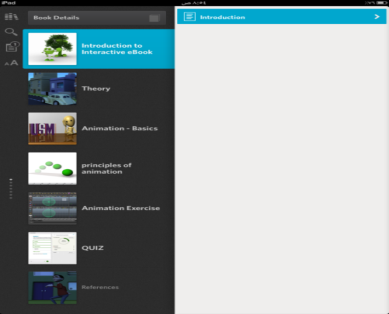 | Figure 2. Inform learners of objectives |
 | Figure 3. Stimulate recall of prior learning |
4.4. Present the Stimulus
- This event of instruction is where the new content is actually presented to the learner. Content of instruction will be first, the interactive eBook itself then, the theory followed by the basic description to discuss the processes of main steps using capture screen, graphics, text, narration and sound effects.
4.5. Provide Learning Guidance
- To help learners encode information for long-term, we will give them additional guidance. We will also provide them along the video show some tips how to apply these steps using graphic symbols and comments.
4.6. Elicit Performance
- In this event of instruction, the learners are required to practice the previous steps of the instruction to confirm their correct understanding of all process, and they can test themselves.
4.7. Provide Learning Feedback
- By use the features of this interactive eBook, the learners can highlight the important things, make notes and share the ideas between other learners and instructors.
4.8. Assess Performance
- Upon completing instructional, most of the students will be able to interact with interactive eBook, learn 3D animation and achieve all objective. So, for assessment performance we will use a checklist to ensure that the instruction solve the problem. And the quiz will show the knowledge performance.
4.9. Enhance Retention and Transfer
- At the end of the instruction the researcher will provide a reference, this step helps the learners internalize the information. They will be able to apply this instruction to master the 3D animation, That the knowledge gained in this instruction will be transferred to other courses.
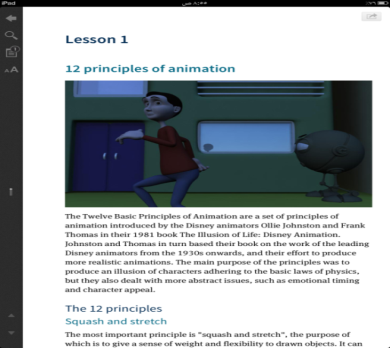 | Figure 4. Present the stimulus |
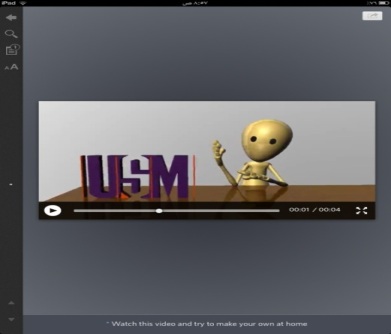 | Figure 5. Provide learning guidance |
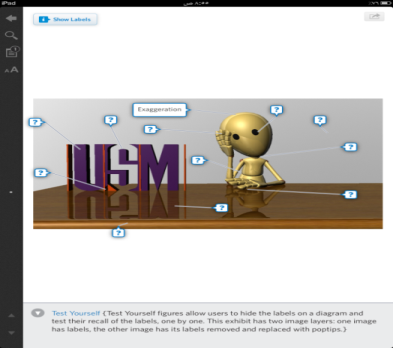 | Figure 6. Elicit performance |
 | Figure 7. Provide learning feedback |
 | Figure 8. Assess performance |
 | Figure 9. Enhance retention and transfer |
5. Select the Instructional Materials
- This material is self-directed learning which initiated and directed by the learner and can include self-paced, independent, and individualized learning as well as self-instruction. This process starts with the following storyboard shown in Figure 10.
6. Design the Materials
- To design the materials, the researcher used different multimedia tools such as Adobe Photoshop, Adobe Illustrator, Adobe After Effect, Autodesk Maya, Autodesk 3Ds Max and HTML files. Figure 11 shows design the material in Photoshop, it show the cover design for the interactive eBook. Figure 12 shows design the 3D animation in Autodesk Maya.After we designed the material and make it in html file, now the turn to insert the content in Inklink to make it interactive. Figure 13 shows the design in Inkling.
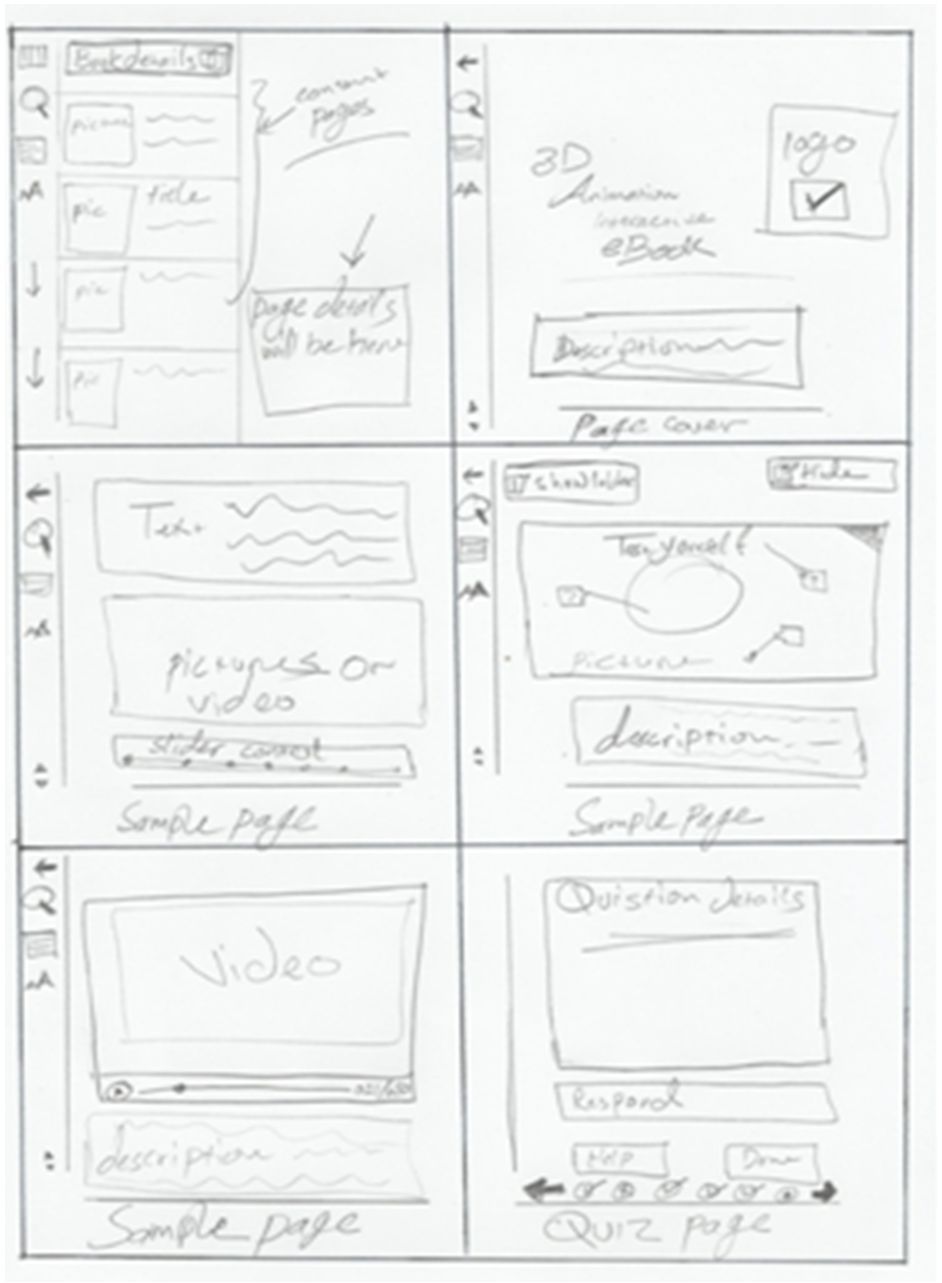 | Figure 10. Interactive eBook storyboard |
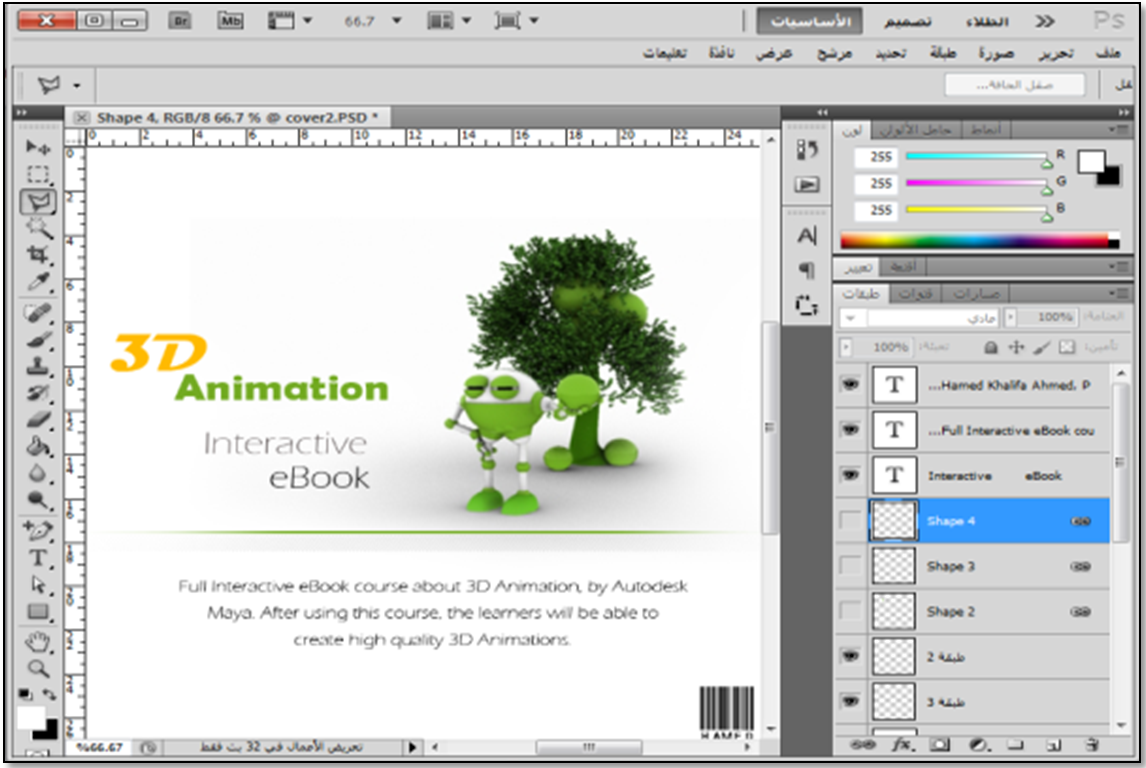 | Figure 11. Design the materials in Photoshop |
 | Figure 12. Design the materials in Maya |
 | Figure 13. the content in in Inkling to apply the interactivity |
7. Final Product
- As we mentioned before, this is an individualized learning as well as self-instruction. It will be available and can be used by different formats as a web, apps for iPad, an app for iPhone, and support any device has a web browser, so the learners can perform and use it at anytime, anywhere.
 | Figure 14. The cover and the book content |
 | Figure 15. Interior page from the Interactive eBook |
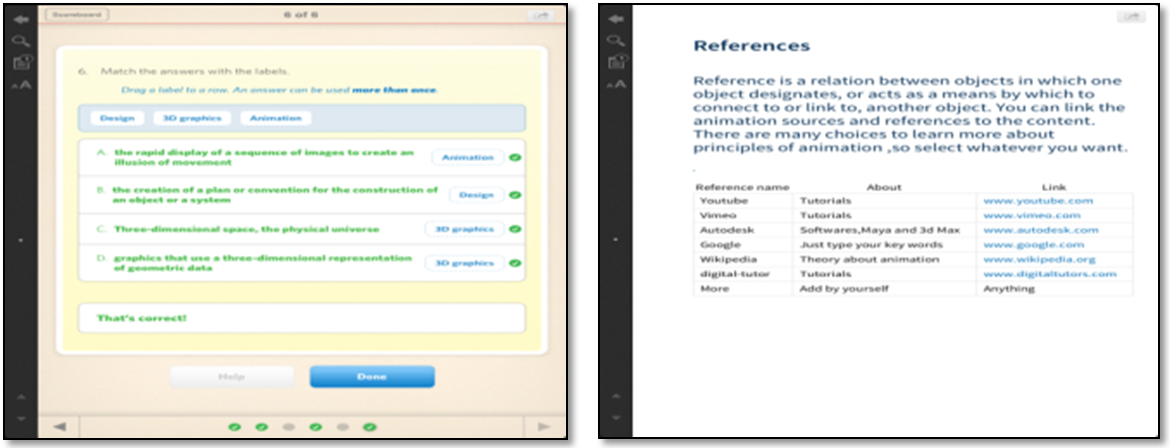 | Figure 16. The quiz and references of the Interactive eBook |
8. Conclusions
- This paper described the importance of applying different instructional design theories into the design of interactive multimedia elements. The Gagne’s nine events of instruction were used by the researcher to provide interactivity among learners of 3D animation. An evaluation of the proposed design is needed to verify aspects that contribute to learners’ intention and motivation to use the proposed design.
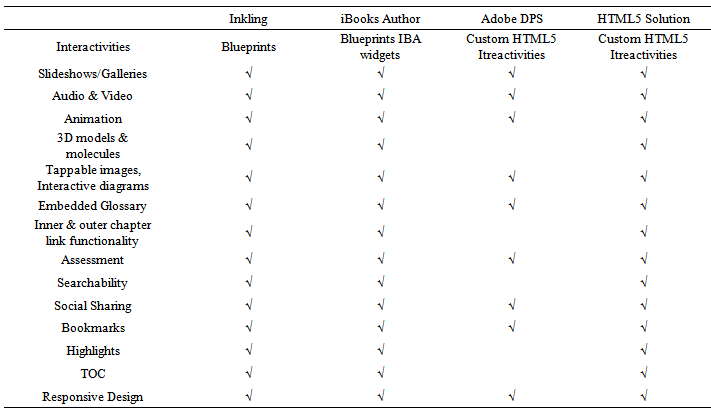 | Appendix 1: Interactive eBooks Platforms Differences |
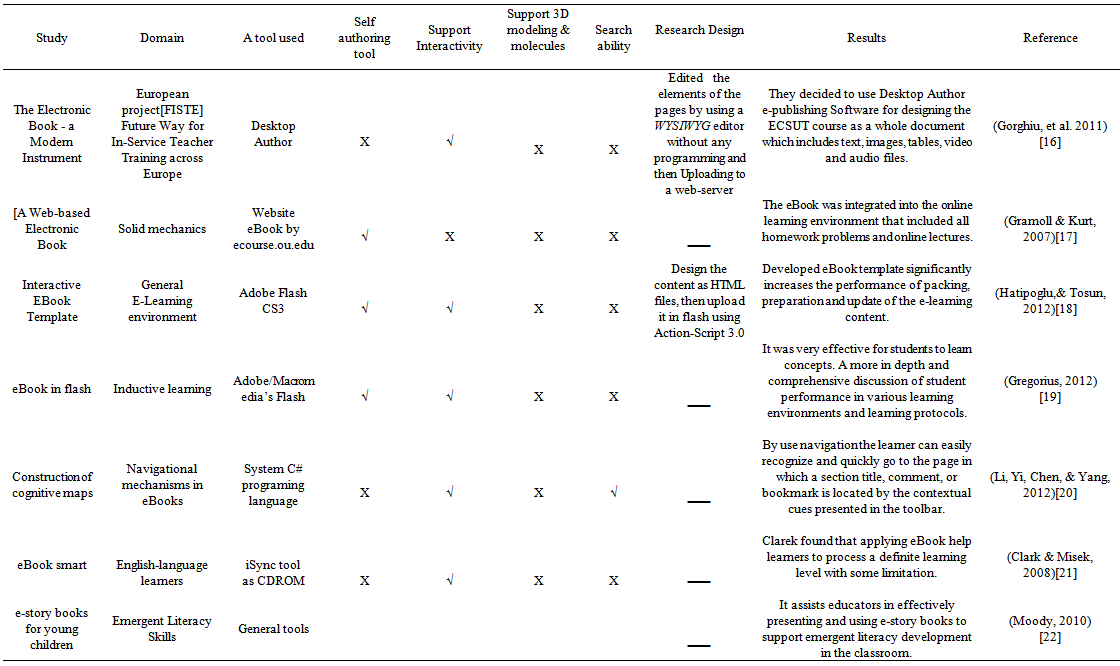 | Appendix 2 : A Comparison Study of Different Multimedia Tools in Design |
 Abstract
Abstract Reference
Reference Full-Text PDF
Full-Text PDF Full-text HTML
Full-text HTML